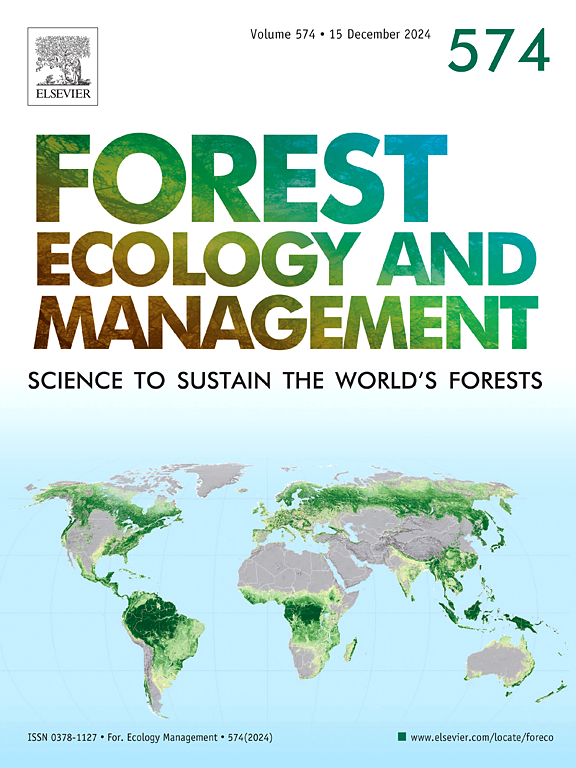评估加拿大不列颠哥伦比亚省沿海森林流域的野火潜力
IF 3.7
2区 农林科学
Q1 FORESTRY
引用次数: 0
摘要
加拿大西部沿海地区的野火干扰随着气候和人类活动的变化而变化。虽然在过去的一个世纪中很少发生,但过去发生过沿海森林的大火,目前和未来的火灾危险是不确定的。我们使用了多种证据来描述加拿大不列颠哥伦比亚省大维多利亚(GVWSA)周围森林供水区域的当代制度,为更广泛地评估太平洋沿岸流域的火灾危险提供了一个框架。局部重大火灾的阈值条件;>10 ha)是根据最近的火灾和天气记录建立的。这些数据用于1)确定GVWSA的基线火险气候学;2)模拟整个区域的火灾行为和年或累积燃烧概率(BP);3)对比BP与古炭样品的晚全新世火回区间;4)利用最近的火灾记录和案例研究评估模型。东部干旱地区的火灾季节比西部干旱地区长14天。近年来(2010-2022年)的火灾季节更为明显,与1996-2009年的较早记录相比,火灾天气指数(FWI)分位数更高。LSF发生在火灾天气指数(FWI)≥ 32条件下(~ 93百分位数),尽管罕见的景观尺度火灾(>;1000 ha)与更极端的事件相关(大约。FWI≥~ 50,约99.6百分位数),特别是夏季流出条件。模型表明,成熟的道格拉斯冷杉(主要植被类型)林分在发生树冠火灾的高至极端危险条件下需要高持续风。总体BP值比内部BP值低50-70 %,而整个GVWSA的BP分布反映了闪电最大值对暴露脊和外围潜在人类点火的影响。模拟火灾的规模大多小到中等(中位数= 52 ha;90年 % & lt;308 ha),在7 公里的火场内,最大的火场达到~ 2800 ha。以木炭为基础的古火重建表明了火的发生模式的持久性。流域周边4个湖泊的数据基本支持景观BP变异。晚全新世的火灾频率始终比周围模拟的现代BP高50-100 %,反映了尽管人为影响发生了变化,但当地气候和地形影响的持久性。SVI森林的野火潜力低于大陆区域,但对水资源和其他价值构成越来越大的风险。环境变化和稀疏的火灾记录表明,多代理方法可以有效地向太平洋沿岸类似地区的管理人员通报火灾危险。本文章由计算机程序翻译,如有差异,请以英文原文为准。
Assessing wildfire potential in a coastal forest watershed, British Columbia, Canada
Wildfire disturbance in coastal western Canada has varied with changes in climate and human activity. Although infrequent during the past century, large fires in coastal forests occurred in the past, and current and future fire hazard are uncertain. We used multiple lines of evidence to characterize the contemporary regime of a forested water supply area around greater Victoria (GVWSA), British Columbia (BC), Canada, to provide a framework for assessing fire hazard more broadly in Pacific coast watersheds. Threshold conditions for locally significant fires (LSF; >10 ha) were established using recent fire and weather records. These data were used to 1) define baseline fire danger climatology for the GVWSA; 2) model fire behaviour and annual or cumulative burn probability (BP) across the region; 3) compare BP with late holocene fire return intervals derived from paleo-charcoal samples; and 4) evaluate modelling using recent fire records and case studies. The fire season was 14 days longer in the drier eastern portion of the watershed compared with the western portion. The fire season in recent years (2010–2022) was more pronounced, with higher Fire Weather Index (FWI) quantiles compared with older (1996–2009) records. LSF occurred under Fire Weather Index (FWI) ≥ 32 conditions (∼93rd percentile), although rare landscape-scale fires (> 1000 ha) were associated with more extreme events (approx. FWI ≥ ∼50, ca. 99.6th percentile), particularly summer outflow conditions. Models suggest that stands of mature Douglas-fir, the dominant vegetation type, require high sustained winds during high to extreme danger conditions for crown fire occurrence. The overall BP was lower (by 50–70 %) than values from interior BC, while the distribution of BP across the GVWSA reflected the influences of lightning maxima on exposed ridges and potential human ignitions outside the perimeter. Simulated fires were mostly small to moderate in size (median= 52 ha; 90 % < 308 ha), with the largest reaching ∼2800 ha within a 7 km fireshed. Charcoal-based paleofire reconstruction suggest the persistence of fire occurrence patterns. Data from four lakes around the watershed generally supported the landscape BP variability. Late-Holocene fire frequency was consistently 50–100 % higher than surrounding modelled present-day BP, reflecting the persistence of local climatic and topographic influences despite changes to anthropogenic influences. Wildfire potential in the forests of SVI is lower than in continental regions but poses a growing risk to water resources and other values. Environmental variability and sparse fire records suggest a multi-proxy approach can be effective for informing managers of fire hazard in similar areas of the Pacific coast.
求助全文
通过发布文献求助,成功后即可免费获取论文全文。
去求助
来源期刊

Forest Ecology and Management
农林科学-林学
CiteScore
7.50
自引率
10.80%
发文量
665
审稿时长
39 days
期刊介绍:
Forest Ecology and Management publishes scientific articles linking forest ecology with forest management, focusing on the application of biological, ecological and social knowledge to the management and conservation of plantations and natural forests. The scope of the journal includes all forest ecosystems of the world.
A peer-review process ensures the quality and international interest of the manuscripts accepted for publication. The journal encourages communication between scientists in disparate fields who share a common interest in ecology and forest management, bridging the gap between research workers and forest managers.
We encourage submission of papers that will have the strongest interest and value to the Journal''s international readership. Some key features of papers with strong interest include:
1. Clear connections between the ecology and management of forests;
2. Novel ideas or approaches to important challenges in forest ecology and management;
3. Studies that address a population of interest beyond the scale of single research sites, Three key points in the design of forest experiments, Forest Ecology and Management 255 (2008) 2022-2023);
4. Review Articles on timely, important topics. Authors are welcome to contact one of the editors to discuss the suitability of a potential review manuscript.
The Journal encourages proposals for special issues examining important areas of forest ecology and management. Potential guest editors should contact any of the Editors to begin discussions about topics, potential papers, and other details.
 求助内容:
求助内容: 应助结果提醒方式:
应助结果提醒方式:


